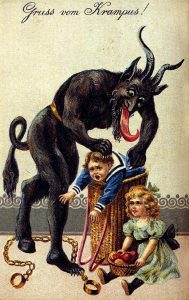Krampusnacht – a nearly forgotten wholesome tradition Krampusnacht
This December 5th get the schnapps ready. For it is customary to offer schnapps to Krampus.
The history of the Krampus stretches back to pre-Christian Alpine traditions. In Central European folklore, Krampus is a horned, human like figure described as “half-goat, half-demon”, who, during the Christmas season, punishes children who have misbehaved, in contrast with Saint Nicholas. Black hair, cloven hooves, horns of a goat and a tongue that rolls out, he carries chains and a sack while gathering bad children. The chains are believed to be an addition by the Christian Church to symbolize the binding of the Devil. Of more pagan origins are the Ruten, bundles of birch branches that Krampus carries and with which he occasionally swats children. Krampus carts off the naughty children in the sack and takes them away for drowning, eating, or transport to Hell. .
The Feast of St. Nicholas is celebrated in parts of Europe on December 6th. On the preceding evening of December 5th, Krampus Night or Krampusnacht, the wicked hairy devil appears on the streets. Unlike North American versions of Santa Claus, in these celebrations Saint Nicholas concerns himself only with the good children, while Krampus is responsible for the bad. Families put plates on their tables, go to bed and wake up to find presents on the plates. If they have been good kids, they get good presents; if they are bad kids, they get Ruten or coal.
Traditionally, adults in the village would dress up as Krampus, while clanging chains in the village streets and running around manically. This running of individuals celebrating Krampusnacht is called a Krampuslauf. More examples of benign traditions include the exchange of Krampuskarten, or cards emblazoned with images of Krampus. Such as this famous picture.

By the 1940s the Austrian government came to take a dim view of this festivity, which often became rowdy when the Krampuses drank to much schnapps. Some Austrian adults feared that Krampus may be scarring children for life. The Krampus tradition was prohibited by the Dollfuss regime under the Nazis, and, in the 1950s, the government distributed pamphlets titled “Krampus is an Evil Man.” The Krampusnacht parade fell into disuse. Supporters of Krampus Yuletide traditions argue that like most modern commercialized holidays, celebrations have been toned down and no permanent damage had been done to the psyches of the Alpine children.
Krampus is making a come back however. In parts of the world adults are again dressing up in fantastic Krampus costumes and drinking schnapps. So this December tell your children the story of Krampus and St. Nicholas. Then pick a few bundles of birch sticks (Ruten) to leave on their plates for the morning.
- Jeremy